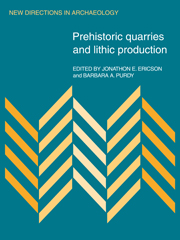Book contents
- Frontmatter
- Contents
- List of contributors
- Dedication
- Part 1 Introduction
- Part 2 Procurement, production, and exchange
- 2 Mount Jasper: a direct-access lithic source area in the White Mountains of New Hampshire
- 3 Procurement without quarry production: examples from southwestern Idaho
- 4 The 63-kilometer fit
- 5 Monopoly or direct access? Industrial organization at the Melos obsidian quarries
- 6 Lithic material demand and quarry production
- 7 Economic aspects of prehistoric quarry use: a case study in the American southwest
- 8 Preliminary report on the obsidian mines at Pico de Orizaba, Veracruz
- 9 State-controlled procurement and the obsidian workshops of Teotihuacán, Mexico
- Part 3 Technology and techniques
- Index
8 - Preliminary report on the obsidian mines at Pico de Orizaba, Veracruz
Published online by Cambridge University Press: 04 August 2010
- Frontmatter
- Contents
- List of contributors
- Dedication
- Part 1 Introduction
- Part 2 Procurement, production, and exchange
- 2 Mount Jasper: a direct-access lithic source area in the White Mountains of New Hampshire
- 3 Procurement without quarry production: examples from southwestern Idaho
- 4 The 63-kilometer fit
- 5 Monopoly or direct access? Industrial organization at the Melos obsidian quarries
- 6 Lithic material demand and quarry production
- 7 Economic aspects of prehistoric quarry use: a case study in the American southwest
- 8 Preliminary report on the obsidian mines at Pico de Orizaba, Veracruz
- 9 State-controlled procurement and the obsidian workshops of Teotihuacán, Mexico
- Part 3 Technology and techniques
- Index
Summary
The obsidian mines at Pico de Orizaba, Veracruz, are important to the study of Mexico's prehistory for at least four reasons: (1) They are some of the best preserved pre-Hispanic mines in the New World, never having been damaged by looters. (2) Due to the unlooted nature of these mines, they provide a highly detailed record of ancient technology in Mexico. (3) They are among the few pre-Hispanic obsidian quarries which can be at least partially dated with considerable confidence. (4) On the basis of results from trace-element analyses, it is very likely that obsidian from the general area of the Pico de Orizaba mines was exploited and traded by Mexico's ancient peoples for thousands of years.
Introduction
Until recently, very few Mesoamerican obsidian quarries have been surveyed or excavated by archaeologists. Most of this chapter will be devoted to describing our fieldwork at the Pico de Orizaba, Veracruz, obsidian mines including the excavations done there by Stocker in 1973 which are still unpublished (Stocker, Cobean & Swibel 1974). To our knowledge the only excavation of a Mesoamerican obsidian quarry previous to the work reported here was done by W. H. Holmes (1900) in his pioneering research at the Sierra de Pachuca in Hidalgo during the late nineteenth century.
- Type
- Chapter
- Information
- Prehistoric Quarries and Lithic Production , pp. 83 - 96Publisher: Cambridge University PressPrint publication year: 1984
- 18
- Cited by

